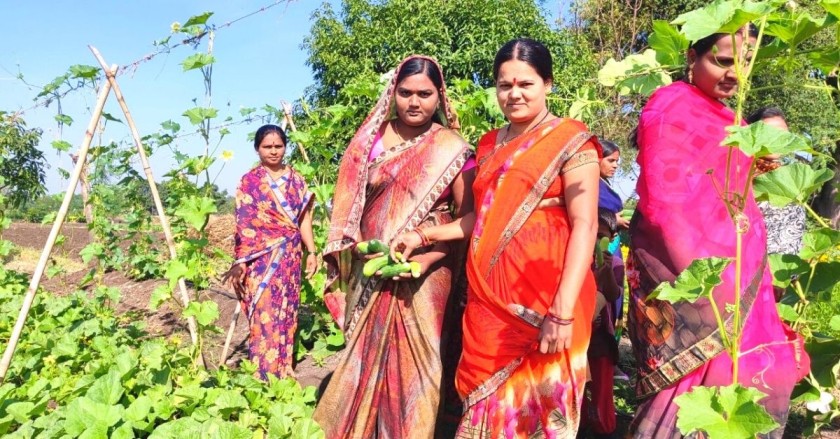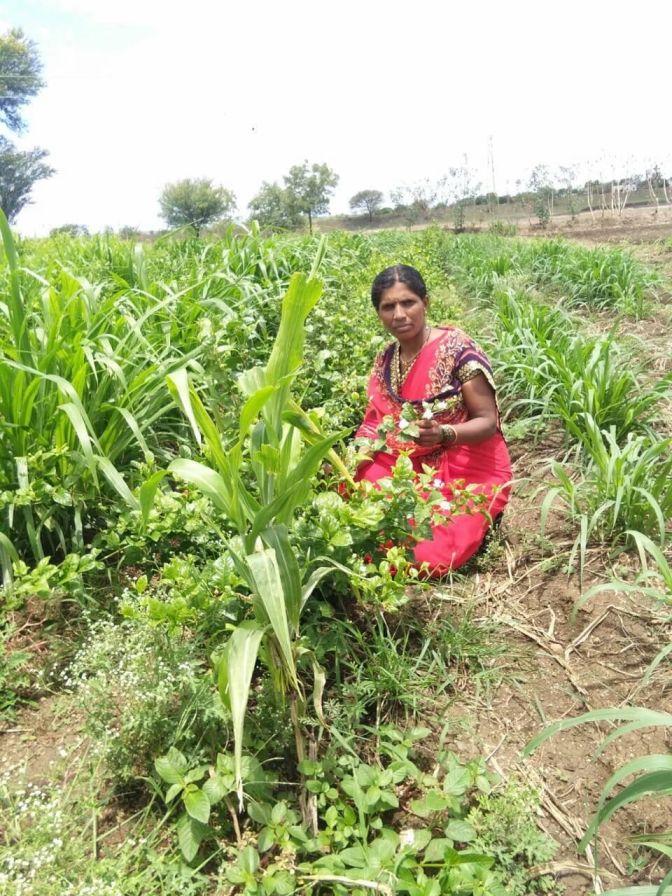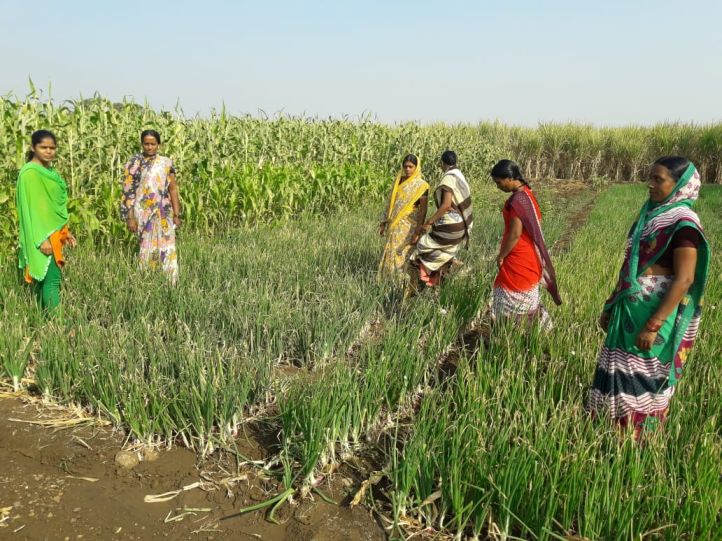How 1,38,000 Women Farmers In Drought-Prone Marathwada Doubled Their Incomes
Women farmers of Maharashtra's drought-prone Marathwada are building a better future through an innovative organic farming model that saves water and doubles production

It was a face-off that Santoshi Survase from Maharashtra’s Latur district had to win at any cost. Her opponent was her husband, and the stakes were high. The end result was going to decide if her 10-year farming experience, self-confidence and knowledge were, in fact, a farce.
Santoshi sowed different varieties of seeds on one acre of land and used the new organic farming technique she had learned. Meanwhile, her husband sowed seeds on the remaining four acres, used high-quality chemical fertilisers and enough water to possibly win the challenge.
The challenge was to see whose farming technique gave more yield. If Santoshi lost, she would have to pay back the price of the seeds to her husband. But more importantly, she would have to part with her pride.
Santoshi prepared quality vermicompost, sowed the seeds as per calculations, and irrigated them regularly.
A year later, Santoshi’s land gave jowar, tomatoes, moong and brinjals, despite the drought-like situation. Meanwhile, the soybean that her husband had sown dried. He could barely salvage a small quantity. The following year, Santoshi implemented the technique on all five acres.
Now, three years later, Santoshi is in charge of all farming-related decisions, and the financial situation of her family – husband and two children – have improved considerably. The Survases are earning Rs 3,00,000 annually, which is a 72% jump from what they were earning in 2018.
Inspired by Santoshi, close to 20 women in her village, Mamdapur, have adopted this organic method, known as the ‘One Acre Model’. The model was developed by Swayam Shikshan Prayog (SSP). It is a Pune-based non-profit that promotes sustainable community development through empowerment of women in entrepreneurship and leadership roles.

Like Mamdapur, several villages across the Marathwada region, which happens to be the worst drought-affected area in India, have seen one-acre models thrive in the last decade.
Marathwada reports nearly 400 suicides in the first six months of the year, as a majority of farmers here heavily depend on rain-fed agriculture. SSP’s model was developed keeping in mind the issues that farmers in this region face the most, including droughts, depleting water tables, pest attacks and rising temperatures.
“Our focus was to empower women farmers by helping them shift to grain, pulses and vegetable farming,” says Tabassum Momin, Program Manager, SSP. “We wanted to make women self-sufficient to meet their food needs. We chose one acre as either these farmers have small holdings, or their families don’t trust them with the land, as was Santoshi’s case. With help of experts, we formulated a multi-cropping pattern that uses less water, more seed, is completely organic and comes with zero investment. The model is a success in the Marathwada region and incomes have doubled.”
So what exactly is a one-acre model, and how does it work?
A multi-cropping system

Since most farmers in the Marathwada region practice a single-cropping system of cash crops such as cotton and soybean, drought or heavy rainfall can destroy the entire field, leaving the farmer with no livelihood. While a multi-cropping system requires more effort, it gives earnings even if some crop is damaged.
“As per the Rabi and Kharif season, we divided the grains, vegetables, pulses and millets and calculated how many crops can be planted on the land. The combination of seeds is selected in a way that they aid each other’s growth. For instance, there are crops that keep pests at bay such as onions, garlic, radish, eggplant and tomatoes. The height of the plants vary as well to provide shade to one another, as well as allow the sunlight to percolate,” says Tabassum.
She adds that raising multiple crops in close proximity will reduce the dependence on chemical fertilisers and soil fertility will improve.
SSP tested the seeds before distributing them to farmers to ensure quality, and calculated the quantity of compost to be used as per the germination rate. The kit that farmers are given to carry out this technique also includes Govan, a powder that can be sprinkled on the seeds to prevent pest attacks.
In terms of cost, this would be zero budget farming from the second cycle, Tabassum says. The crops grown can be used for self-consumption which can save approximately Rs 46,000 on groceries and Rs 11,500 on chemical inputs yearly. The farmers save nutrient-rich seeds and sow them again for the next cycle, thus eliminating the need to buy more in future.
Meanwhile, the women are taught to prepare vermicompost at home and are even encouraged to sell it. Santoshi’s compost is widely preferred in her village so she has an extra revenue source.
The experiments began with three groups each comprising 20 women. At present, close to 1,38,000 women farmers are reaping the benefits.
A tool of empowerment

The Better India speaks to Santoshi and Kalavati Pawar, who is from Yedola in Osmanabad, to know how their lives have changed. The duo has also inspired fellow villagers to adopt the model.
“I am not educated but SSP gave me a chance to learn something that would improve my life. We were tired of taking loans and not being able to provide for our children. We struggled for water during scanty rainfalls,” Santoshi says.
Explaining how she uses the technique, she adds, “I made a vermicompost bed from a recycled tarpaulin and installed sprinkles for better irrigation. The compost absorbs and retains water for a longer period, thus keeping the crops moist. So even if there is a drought, we just sprinkle some water, which will sustain. I grow brinjal, tomatoes, dals, leafy vegetables, pumpkin and more on a rotational basis. We get a one-kilo harvest per acre, and two kilos if it’s dal.”
With the increased income, Santoshi has invested in her children’s education and purchased machines to make papads and generate more income. She even helps beginners set up composting beds and gives seeds and compost for free. More than the money she is earning, she is happy about spreading her knowledge.
Meanwhile, for Kalavati, who is in her late thirties, it is a matter of honour, given that she wasn’t allowed to even step outside her home due to old customs. Her journey is all about finding her own identity and changing her family’s perception.
“I joined SSP in 2016 and received training on cost-effective farming. Earlier, I was shy to talk to people, but now I teach them. I even learnt how to operate the internet and downloaded agriculture-related apps to boost my yield. Initially, my husband didn’t like all this but when he saw the yield outcome, he was a changed man. From just an acre I earn up to Rs 50,000 per cycle which is a lot compared to chemical farming. My daughter wants to study engineering or get into the police force. Now, at least I know I can afford the cost of her studies,” she adds.
For women like Kalavati and Santoshi, who have been toiling hard under the sun for years only to get a meagre income, this one-acre model has not only improved their finances but even strengthened their role in the community. Farming may just be a profession for many, but for women in Marathwada, it is a tool of empowerment.
Edited by Divya Sethu
If you found our stories insightful, informative, or even just enjoyable, we invite you to consider making a voluntary payment to support the work we do at The Better India. Your contribution helps us continue producing quality content that educates, inspires, and drives positive change.
Choose one of the payment options below for your contribution-
By paying for the stories you value, you directly contribute to sustaining our efforts focused on making a difference in the world. Together, let’s ensure that impactful stories continue to be told and shared, enriching lives and communities alike.
Thank you for your support. Here are some frequently asked questions you might find helpful to know why you are contributing?


This story made me
-
97
-
121
-
89
-
167











